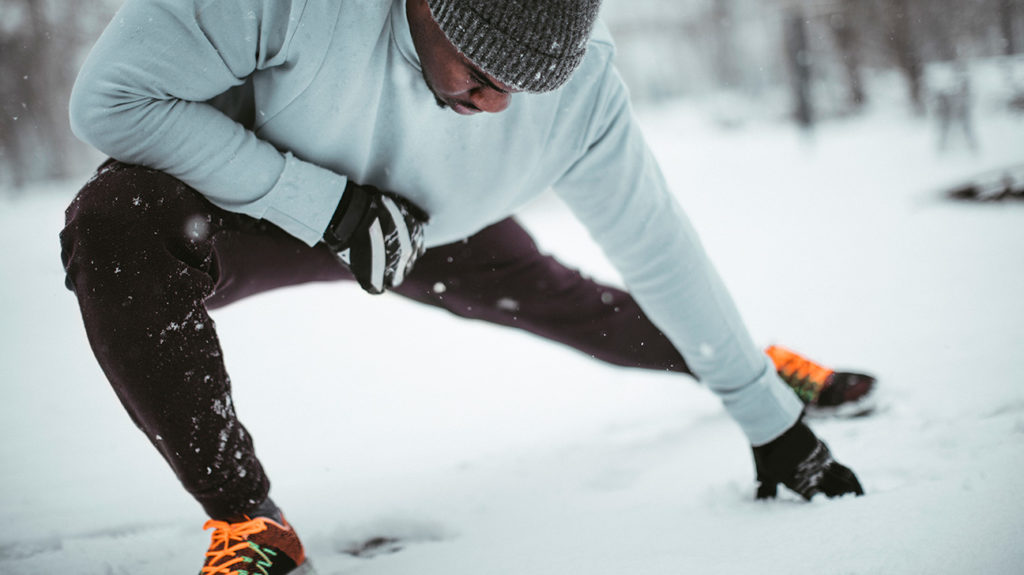Exercising in Cold Weather

Why Exercise in the Cold?
#1 - Exercising in the cold might seem like a foreign idea; it might seem to be entirely out there. It is incredibly beneficial for you in several ways. Aside from the added vitamin D dose, it is also known to be good for your immune system.
#2 - Exercising outdoors in cold weather is also a critical factor in burning extra calories - if winter weight gets you down, working out in the cold can help. Studies have shown that cold weather converts white fat into brown fat - think of brown fat as fuel. It burns throughout your workout leading to additional fat loss and calories burnt.
#3 - Staying awake and excited to workout is another factor. You are more likely to stay alert and active in the cold. Think about it; sweltering hot summer days can have you sweating without moving, exercises are interrupted with long breaks between to mop up sweat and cool down before getting back into it. Cold weather will keep you actively moving throughout your workout.
#4 - Longer and harder workouts are common in the cold. The cold makes it a lot easier to work out for longer, and you might experience enhanced endurance. The cold can help you regulate your temperature a lot easier.
Cold Weather Workouts
Here is a quick guide to structuring your winter warmer workout. All workouts need a warm-up and a cool-down. It is imperative in chilly weather.
Warm-Up
Before heading out to get cool and fit, try a quick indoors dynamic stretch with resistance bands. Warming your muscles up and activating them is key to a successful outdoor workout.
Warmed-up muscles mean you will get the most out of your exercise without risking injury. The cold weather can make injuries worst or a lot more uncomfortable.
Working out
Running, skiing or even cycling in the cold are excellent ways to get your workout on. Also, you can have lots o fun with sled pulling! Outdoor functional training is also easy in winter; make sure you have gloves on if you are flipping tires in frosty temperatures.
Hiking trails in winter is an excellent form of outdoor exercise. It has all the benefits of raising your heart rate and a healthy dose of nature therapy.
Cool-down
It is imperative to cool off after any workout. When it comes to outdoor winter training, it is essential that you cool down and change out of your clothing as fast as you can.
Clothing that is damp from sweat, snow, drizzle, or rain can cool down too fast and lead to health risks. If you can head indoors or away from a breeze to cool down, that is best. Try tapering the intensity of your workout down gradually towards the end.
The Risks and How to Stay Safe
Just as with any kind of exercise, there are risks involved with cold-weather exercise. You should be aware of the risks so that you can avoid injury.
Weather Conditions
Keep an eye on the weather. Considering that it might look safe out, however, the wind chill can make it feel colder than it is. Try not to workout in sub-zero temperatures. If the weather is likely to shift or become colder, opt for an indoor activity.
Consider wearing a mask or a face covering; this prevents cold air from hurting your lungs. Cold, dry air can impact people with asthma and lead to an asthma attack.
Hydration
You need to stay hydrated before, during, and after your workout. If you can, keep a thermos of warm herbal tea for after your workout. It is much easier to drink and can warm you up as you stop working out.
Getting Dressed
Dressing appropriately is essential. Non-slip quality shoes are necessary if you are going to be on a slippery and wet surface. Layers of clothing are advised; should you get too hot and start sweating, you can remove a layer. Putting the layer of clothing back on as soon as you begin to feel a little too cold again. Winter and summer clothing is made of different materials, it is important to invest in the right gear.
Take a jacket with you, and get indoors to change as soon as possible if you are sweaty. The sweat will cool-down on your clothing fast, especially if there is a breeze. If it is snowy in you area, it is vital to protect your eyes by wearing sunglasses and eye protection; the dazzling glare of light on the snow can be harmful to your eyes.
Be on the Lookout
Frostbite is a risk that you need to be on the lookout for. Frostbite occurs when blood vessels constrict - or narrow - with less blood in the area ant other fluid will begin to freeze.
Frostbite is dangerous and can cause severe blistering and have long-lasting effects. It is crucial to have a layer of clothing covering your skin. Thin thermal winter workout gear is ideal. The frostbite areas are the nose, ears, cheeks, hands and feet, toes, and fingers. They are the areas most often exposed to the cold. If you have frostbite, seek medical attention immediately.
A Frosty Advantage
There are clear benefits to working out in the colder weather, even if you need to be a little more cautious than usual. Exercising in the cold can be fun and safe if you practice sensible safety and are aware of the risks.
.jpg)
.jpg)

.png)


.jpg)


